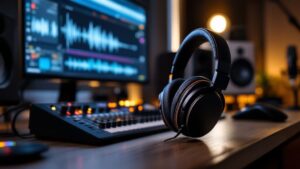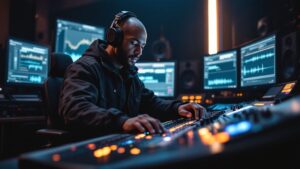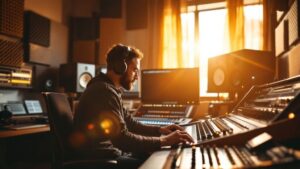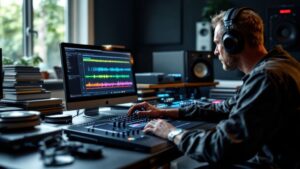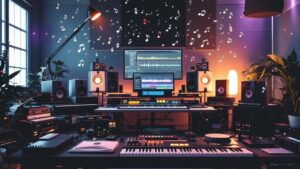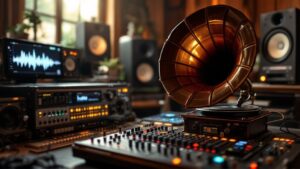The Evolution and Impact of Sound Engineering
Sound engineering's journey from basic recording methods to today's advanced systems has shaped how we create and experience audio. This field connects technical skill with creative artistry, making it possible to capture and enhance sound in ways early pioneers could only dream of.
From Mechanical Marvels to Digital Domains
The field began in the Acoustic Era (1877-1925) with purely mechanical devices. Thomas Edison's phonograph in 1877 marked the start, using horns to gather sound waves that were then etched onto wax or metal. These early recordings could only capture frequencies between 250 Hz and 2,500 Hz, which meant musicians had to adapt – playing louder and carefully positioning themselves around the recording horn.
The Electrical Era (1925-1945) brought microphones and amplifiers into the studio. This advancement expanded what could be recorded, allowing engineers to capture softer instruments and more subtle sounds. The improved technology meant recordings could finally start matching the richness of live performances.
The Rise of Magnetic Tape and Multi-track Recording
Magnetic tape changed everything in the mid-20th century. It offered better sound quality and introduced multi-track recording, letting engineers record instruments separately and mix them later. This new capability opened up creative possibilities that weren't possible before, allowing for detailed sound editing and layering that became essential to modern music production.
The Digital Revolution and Beyond
The shift to digital tools in the late 20th century made high-quality recording more accessible than ever. Digital Audio Workstations (DAWs) and digital processing gave individual artists and engineers powerful creative control. These tools continue improving, adding new ways to shape and perfect sound while building on core engineering principles.
The Impact on Music and Beyond
Sound engineering's growth has influenced every type of music we hear today. From early blues recordings to complex modern productions, engineering techniques help define each genre's signature sound. The field's influence extends far beyond music – it's crucial for film, TV, gaming, and virtual reality. As new technology emerges, sound engineers blend traditional knowledge with new tools to create engaging audio experiences across all media forms.
Mastering the Physics of Professional Audio
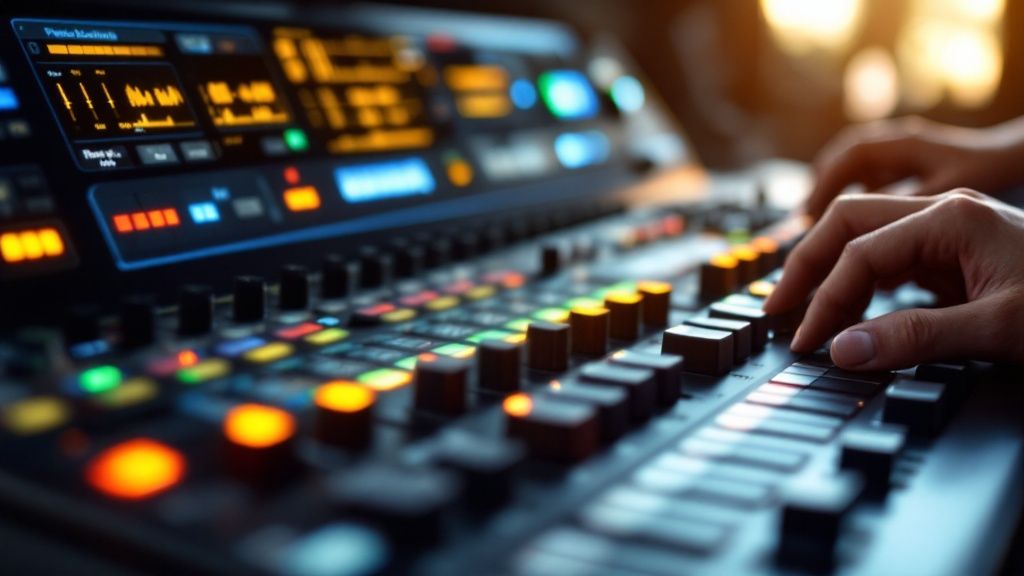
Anyone working in audio needs to grasp the physics behind sound. Understanding these core principles helps you shape and control sound effectively, leading to better recording and mixing decisions. Let's explore the key concepts that make up the foundation of professional audio.
Understanding Sound Wave Behavior
Sound moves through air and other materials as waves of pressure. When you pluck a guitar string or hit a drum, that vibration pushes air molecules together and apart, creating waves that spread out in all directions. These waves travel at different speeds depending on the material – in air at room temperature, sound moves at 1,125 feet per second.
Key Properties of Sound Waves
The main characteristics that define sound waves include:
- Frequency: Measured in Hertz (Hz), this determines the pitch we hear. The human ear can detect frequencies from 20 Hz to 20,000 Hz. Lower frequencies create bass sounds while higher frequencies make treble sounds.
- Amplitude: This measures how loud a sound is, using decibels (dB). Every time the amplitude increases by 6dB, the sound appears twice as loud to our ears.
- Wavelength: The physical distance between wave peaks. High-pitched sounds have short wavelengths, while low bass notes have long wavelengths.
- Phase: Where a wave is in its cycle, measured in degrees from 0° to 360°. Phase relationships matter when combining multiple sound sources.
How Sound Changes Over Time and Distance
As sound waves travel, several factors affect how they behave:
- Attenuation: Sound naturally gets quieter over distance as the energy spreads out. High frequencies fade faster than low frequencies.
- Reflection and Refraction: Waves bounce off surfaces and bend when moving between different materials. This shapes how sound behaves in rooms.
- Diffusion: When sound hits uneven surfaces, it scatters in different directions. This helps create an even sound field in a space.
- Doppler Effect: The apparent change in pitch when sound sources move relative to the listener – like a passing siren changing from high to low pitch.
Applying Physics to Sound Engineering
This knowledge directly applies to many audio tasks:
- Microphone Placement: Understanding how sound waves move helps you position mics to capture the best sound while avoiding unwanted noise.
- Room Treatment: By managing reflections and absorption, you can make rooms sound better for recording and mixing.
- Mixing and Mastering: Working with frequencies, levels, and phase helps create clear, balanced mixes. For mixing tips and techniques, visit The Audio Pod.
When you understand these basic physics concepts, you can work more effectively with sound. Instead of guessing, you'll know how to solve problems and achieve the results you want. This foundation will serve you well as you develop more advanced audio skills.
Building Your Professional Audio Arsenal
Getting the right audio equipment requires careful planning and understanding of your needs. Let's explore how to create a reliable audio setup that works for you, whether you're at the beginning of your journey or upgrading your current gear. We'll cover practical buying strategies and help you make smart choices about which equipment to get first.
Essential Components and Smart Investments
Think of audio equipment like a chef's kitchen tools – each piece serves a specific purpose. Here are the key components you'll need:
-
Digital Audio Workstation (DAW): This software is where you'll record, edit, and mix your audio. Pick one that feels natural and matches how you like to work. Popular options include Pro Tools, Logic Pro, and Ableton Live.
-
Audio Interface: This converts analog signals from mics and instruments into digital data for your computer. Good interfaces provide clean, noise-free recordings.
-
Microphones: Different mics work best for different sounds. Start with versatile options that can handle multiple sources well.
-
Monitors: Quality studio monitors show you exactly what your mix sounds like, without boosting or cutting frequencies artificially.
-
Headphones: You'll want both closed-back headphones for recording (to prevent sound leakage) and open-back ones for mixing (for better sound detail).
Prioritizing Your Purchases: A Tiered Approach
Here's a practical way to build your setup over time:
-
Tier 1: Essential Tools
- A reliable DAW
- Basic audio interface
- One versatile microphone
- Professional closed-back headphones
-
Tier 2: Enhanced Setup
- Additional microphones
- Studio monitors
- Open-back headphones for mixing
-
Tier 3: Advanced Gear
- Microphone preamps
- Hardware compressors
- Specialized plugins
Evaluating Equipment Beyond the Specs
Numbers and specs only tell part of the story. Here's what really matters:
-
Trust Your Ears: Compare gear using music you know well. This helps you spot subtle differences in sound quality.
-
Consider Your Process: Some fancy features might actually slow you down. Choose equipment that helps you work efficiently.
-
Learn From Others: Check detailed reviews and ask experienced engineers for advice. Their real-world experience can help you avoid costly mistakes.
Building a professional audio setup takes time and careful consideration. Focus on getting gear that actually improves your work, rather than chasing the newest products. With smart choices and patience, you'll develop a setup that helps you create great audio.
Advanced Recording Techniques That Actually Work
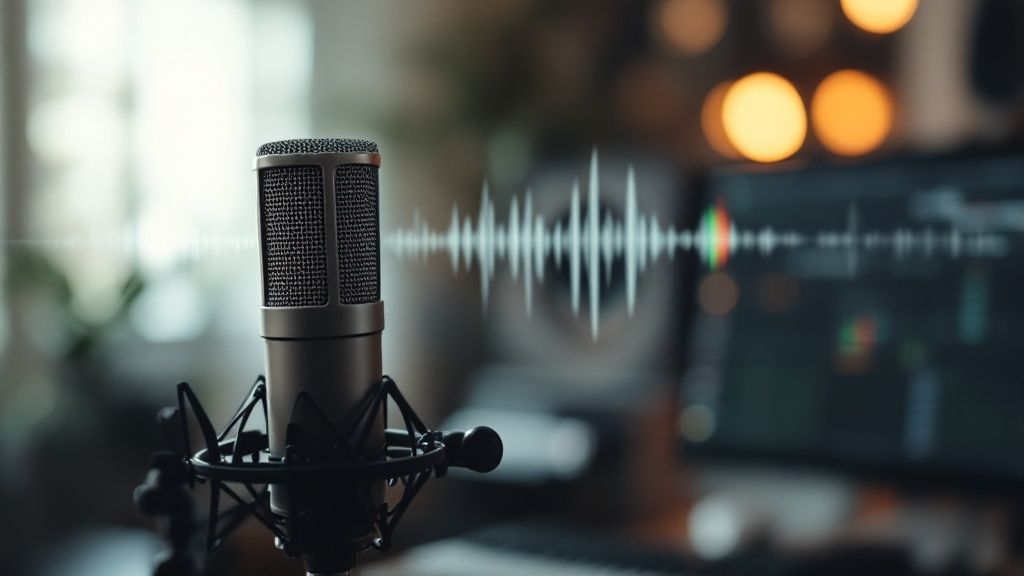
Let's explore how professional sound engineers take their recordings to the next level. Whether you're working with vocalists, bands, or orchestras, these proven methods will help you capture exceptional audio quality.
Capturing Emotion: The Human Element in Recording
Technical skills alone won't create amazing recordings. The magic happens when you understand the artist's vision and create an environment where they can deliver their best performance. Sometimes, moving a microphone just a few inches can completely change how intimate a vocal track feels.
Building trust with artists is just as important as knowing your equipment. When performers feel comfortable and inspired, they naturally give more emotional depth to their takes. A positive studio atmosphere often makes the difference between a good recording and an unforgettable one.
Practical Solutions for Common Recording Challenges
Every session brings its own set of problems to solve. Unwanted room noise and instrument bleed are frequent issues, but there are reliable ways to handle them. Smart microphone placement using directional mics and thoughtful room setup can minimize sound leakage between instruments.
When dealing with inconsistent performances, the ability to combine the best parts of multiple takes becomes crucial. This "comping" process lets you build a polished final version, even when individual takes have small flaws. With careful attention to timing and transitions, the result sounds natural and professional.
Innovative Approaches to Traditional Techniques
While classic recording methods still work great, trying new approaches can lead to exciting results. Mixing vintage analog gear with modern digital tools gives you the best of both worlds – the warmth of tubes and tape plus the precision of digital editing.
Mid-side (M/S) stereo recording is a perfect example of an advanced technique that gives you more control. By capturing the middle and sides of the sound field separately, you can adjust the stereo width during mixing to create exactly the right sense of space.
Real-World Examples from the Pros
Different genres need different approaches. Classical recordings often aim for a natural, open sound with minimal processing. Pop and rock tracks typically use more compression and EQ to achieve that radio-ready punch. Tune Tailors, a production studio in Perouges, France, shows how to adapt these techniques for each project, from album mixing to sound design.
By mastering these advanced recording methods and staying flexible in your approach, you'll consistently capture better audio. The small details – mic choice, placement, room treatment, and performance quality – all add up to make truly professional recordings that stand out.
Mixing Strategies That Transform Your Sound
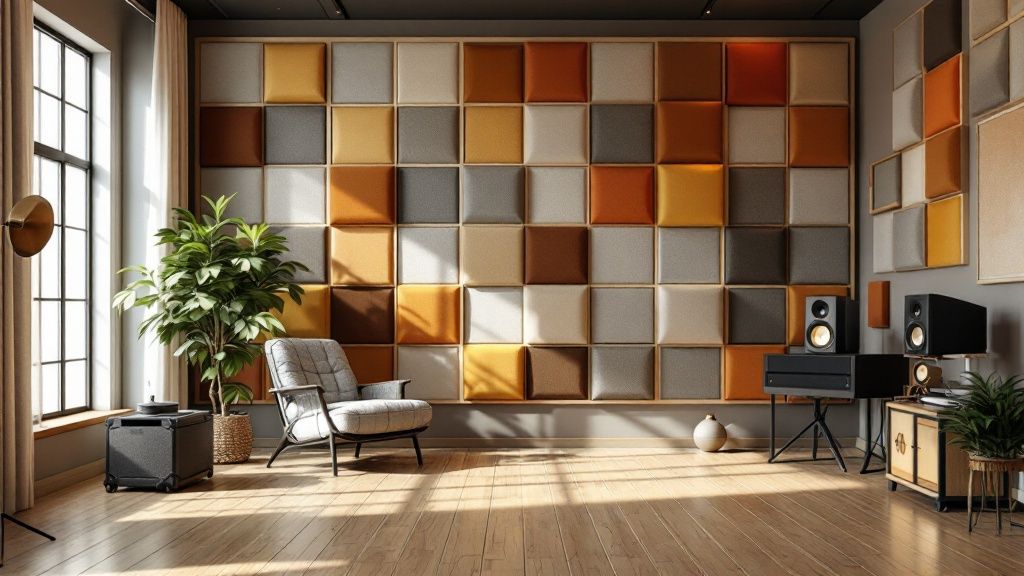
The art of mixing brings together technical skill and creative expression. This crucial phase combines individual tracks into a polished final product with depth, punch and clarity. Let's explore proven mixing approaches used by professional sound engineers, from setting up an efficient workspace to applying advanced processing techniques.
Workflow Strategies for Efficient Mixing
Just like constructing a building needs a solid foundation, successful mixing requires careful preparation and organization. A well-structured workflow helps you stay focused on the creative aspects rather than getting bogged down by technical issues. Here are key setup steps:
- Track Organization: Use color coding, group similar instruments, and maintain consistent naming to easily navigate your session
- Gain Staging: Set proper levels for each track before mixing to prevent clipping and ensure a balanced starting point
- Initial Balance: Create a basic mix of all tracks early to establish the general sound and direction. This provides a roadmap for detailed work later.
Taking time for proper setup at the start gives you more creative freedom as you dig into the detailed mixing process.
Advanced Processing Techniques
With your foundational mix in place, you can begin applying processing tools to enhance and shape the sound. Think of these tools like seasoning in cooking – they can subtly enhance or dramatically transform the final result:
- Equalization (EQ): Shape frequency content to create space for each instrument and achieve overall tonal balance. Learn more about EQ techniques in this guide to Correcting Frequency Imbalances Using Equalizers.
- Compression: Even out volume levels and add punch by controlling dynamic range. Explore compression settings in this article on Fixing Problems Using Audio Compression.
- Reverb and Delay: Create depth and space by placing sounds in virtual environments, from intimate rooms to large halls.
- Automation: Add movement and interest by varying parameters like volume, panning and effects over time. This brings life and emotion to static tracks.
Developing Your Unique Mixing Style
While mastering the technical basics is essential, your personal creative approach makes your mixes stand out. Just as every painter has their signature style, each engineer brings their own perspective to mixing:
- Try New Things: Don't be afraid to break conventional rules and experiment with unusual techniques. Some of the best results come from creative exploration.
- Train Your Ears: Develop your listening skills to pick up subtle sonic details and understand how processing affects the mix. Regular critical listening helps you make better mixing decisions.
- Work with Others: Collaborating exposes you to fresh ideas and approaches. Different viewpoints often lead to better final results.
By combining solid technical knowledge with your unique creative vision, you can craft mixes that are both professionally polished and artistically engaging. This personal touch helps capture the emotional heart of the music and creates a lasting impact on listeners.
Professional Monitoring and Quality Assurance
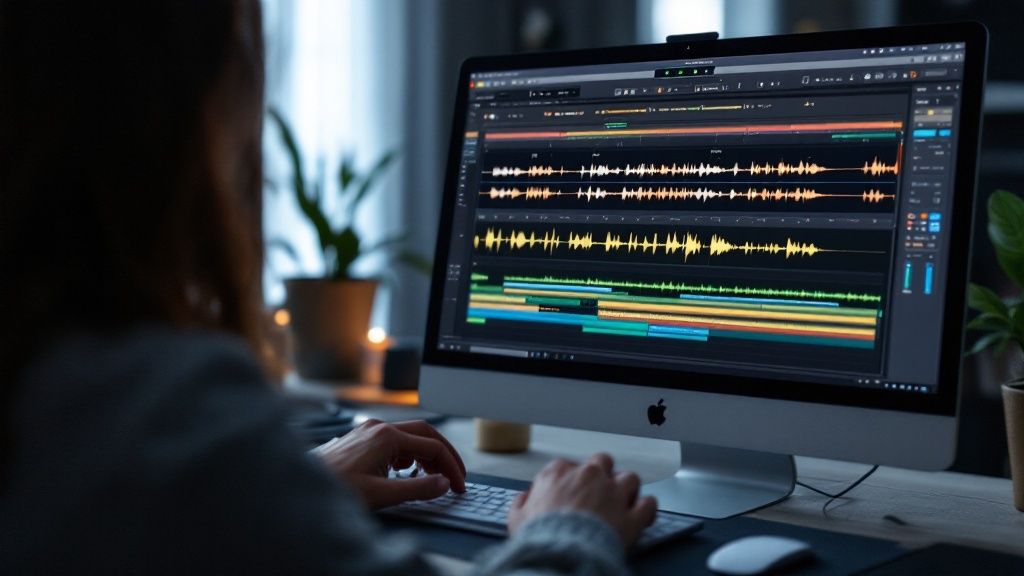
Great audio production requires careful monitoring and quality control to ensure excellent sound across all playback systems. Setting up proper monitoring, building listening skills, and following solid quality checks are essential building blocks. These core practices help your audio reach its full potential.
Creating an Optimal Listening Environment
Your listening space directly impacts how you hear and evaluate sound. An untreated room can add unwanted echoes and frequency problems that affect your mixing decisions. This is why room calibration matters so much.
Well-placed acoustic panels can absorb sound reflections and reduce echo for clearer monitoring. Bass traps in corners help control low frequencies for more accurate bass response. You don't need expensive solutions – even adding rugs or bookshelves can improve your room's sound. Many online resources offer practical tips for room treatment and calibration.
Developing Critical Listening Skills
Beyond room setup, strong critical listening skills are key. Train your ears to notice subtle differences in frequencies, dynamics, and stereo placement. Compare your mixes on different speakers and study professional recordings as references.
This practice shows you how your mix translates to various systems and helps spot potential issues. A mix may sound perfect on studio monitors but lose clarity on smaller speakers. Careful listening helps catch problems early. Check out The Audio Pod for mixing and mastering tips.
Implementing Effective Quality Control Processes
A clear quality control process maintains consistent audio standards. Test your mixes on many playback systems – from pro studio monitors to consumer headphones and car speakers.
Having another engineer review your work provides fresh perspective and catches issues you might miss. This team approach improves quality control for more polished results. Tune Tailors in Perouges, France shows how these fundamentals enhance their mixing and mastering work.
Monitoring Solutions for Different Budgets
You can build a solid monitoring setup without huge expense. Entry-level studio monitors and headphones often provide great value. While better gear can improve accuracy as your budget grows, proper room treatment and developing your ears usually bring bigger benefits than just buying expensive equipment.
Real-World Applications and Case Studies
Looking at real audio engineering examples shows how pros handle monitoring and quality control. Learning from their challenges and solutions helps guide your own projects. These cases demonstrate how sound engineering basics lead to great results in professional studios.


